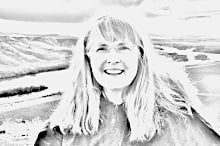No products in the cart.
Cabin Culture

The Allure of Rustic Living
By Diana Hooley
People are drawn to pop culture, sports culture, or the culture of their heritage—but cabin culture? I’d never heard this term before my friend Paul used it to describe the lifestyle in Idaho’s central mountain region.
At the time, we were at a music jam in a brewery on the outskirts of McCall. “These folks here,” Paul said, gesturing to the crowd of people in folding chairs around us, “they’re all part of the cabin culture.”
Giant stainless-steel fermenting tanks stood at one end of the high-ceilinged brewery, and at the other was the stage. A group of Baby Boomers and Baby Boomer wannabees (is there such a thing?) sat in a circle of chairs playing guitars, mandolins, and fiddles. The dress code for this shindig was floppy hats and heavy-duty work shirts. Though I felt a little out of my element in my yoga pants, I did enjoy the music. It was a rousing mix of folk songs and hillbilly rock.
“Tell me more about this cabin culture,” I said to Paul.
Obviously, one aspect was the music, but what else did the culture involve? Did a person have to live in a cabin? And, why were people drawn to the lifestyle?
“It’s not just about living in a cabin,” he said. “It’s a way of life. Do you know what hygge means?”
Paul grew up in Minnesota among people of Scandinavian descent. He explained hygge was a Danish word that means having a cozy, comfortable environment, which engenders feelings of contentment. “When I think of hygge,” he continued, “I think of sipping hot tea, or sitting next to the woodstove in my wool socks, eating a bowl of soup and bread.”
Paul said woodstoves and wood construction are important aspects of cabin culture. I talked with other friends, Don and Kristi, who live in New Meadows. They wanted to show me their beautiful cedar-sided home. Don said they built the house around their woodstove, but also installed a heat pump, which draws air from underground pipes. Kristi said she liked the hominess of a woodstove fire. She said mornings are cold in New Meadows and freezing temperatures can happen even on the Fourth of July.
In a McCall yarn shop, I met a woman named Karen. Knitting, quilting, woodwork, and other traditional crafts apparently also have a place in cabin culture. Karen told me she moved to Cascade from Florida. “In Florida I had a pool and a screened-in lanai to keep the alligators out. It was great, but I like our home in Cascade. It was built in 1938 and has knotty pine walls and a hickory floor. I love the woodsy smell.”
Avi, a McCall realtor, is aware of cabin culture in Boise and Adams County. But, he cautioned, the word “cabin” means different things to different people. “You might hear someone say they’re going up to the cabin for the weekend and their cabin might be a trailer, an A-frame, or a sprawling mansion on Payette Lake.”
Avi said there are traditional-looking cabins in the area, too, most of them built in the forties and fifties of log and daub construction. They aren’t insulated very well and often serve only as summer residences. “But really,” Avi said, “it’s more about living in the outdoors. People want to recreate here. They come to McCall to boat, ski, hunt, or hike.”
Paul spoke about the significance of the outdoors too, but in a different way. He said the cabin culture lifestyle brings you physically closer to nature. When you have a home in the woods, mountains, or next to the lake, you become more attuned to the natural world. “A loon rises off the marsh, or you hear the call of a belted kingfisher,” he said. “It’s a spiritual experience. It’s a way of life that satisfies in many ways.”
This content is available for purchase. Please select from available options.
Purchase Only
Purchase Only

